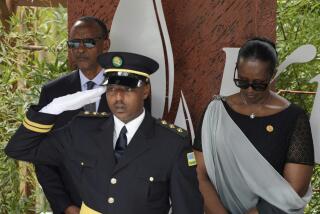A New Take on the 1961 Murder of Congoâs Leader
BRUSSELS â Patrice Lumumba is an enduring icon of liberation for Africans, the man who led Congo to independence only to be treacherously murdered. His slaying 45 years ago made him a martyr, but also left a persistent mystery: Who gave the order to kill him?
Experts agree that Belgium, which ended nearly a century of colonial rule in Congo on June 30, 1960, conspired to overthrow its only democratically elected prime minister. Some maintain that the Belgian elite, including then-King Baudouin, were directly to blame for his execution.
Jacques Brassinne, a leading Belgian expert on events leading up to the murder, has added a new twist to the debate. He argues that although Belgian officers had an active role, the man who directly ordered the killing was Godefroid Munongo, interior minister of Katanga, now Shaba, the mineral-rich southern province that sought to break away from Congo.
The circumstances surrounding Lumumbaâs death have long been contentious in Africa and in Belgium, and much of the evidence has pointed to Congoâs former colonial master.
In 2001, a Belgian government commission declared that Belgian authorities bore âmoral responsibilityâ for the murder of Lumumba, who had intended to nationalize Western mining interests in Katanga.
The inquiry determined that months after a September 1960 coup dâetat by Col. Joseph Mobutu, Lumumba was captured and jailed in the capital, Leopoldville, now Kinshasa. On Jan. 17, 1961, Belgian officials spirited Lumumba and two of his government ministers away by plane to Katanga, it said.
There has also been speculation that the United States and Britain might have been involved. It was the height of the Cold War, and the charismatic leftist leader was seen as a potential threat because he made overtures to the Soviet Union. Katangaâs production of weapons-grade uranium vastly raised the stakes for global players.
A U.S. congressional committee said in the mid-1970s that American operatives engaged in plots to kill Lumumba but it found no evidence of their involvement in the actual killing.
Whatever the involvement of others, Brassinne contends the explicit order came from the leadership of Katanga, whose economy was controlled by Union Miniere, a Belgian mining conglomerate that bankrolled the provinceâs secession.
He said he based his conclusions on extensive interviews with all surviving witnesses, including officers, politicians and even the pilots of the Sabena airlines DC-4 airliner that took the prisoners to Katanga.
He allowed the Associated Press to examine his report, which contains numerous photos and sketches of the murder scene. He plans to donate his papers to the Museum of Central African History near Brussels.
Brassinne said Katangaâs secessionist leaders, headed by its Belgian-appointed president, Moise Tshombe, didnât know Lumumba was coming until the plane touched down in Elisabethville, now Lubumbashi. Tshombe and his government ministers hurriedly met near the airport to decide what to do, he said.
âThe decision to kill them was made by Munongo, who insisted that they should be put to death. Tshombe and others wanted to keep him in jail, but eventually acquiesced to Munongoâs insistence that he be eliminated,â said Brassinne, who at the time served in the Belgian Consulate in Katanga and later wrote a doctoral thesis on the events there.
âWhen Tshombe expressed concern about the international repercussions such a move would produce, Munongo answered, âWhy should we care?â â Brassinne said.
Munongo ordered Belgian officers assigned to the Katanga police to assemble a firing squad, Brassinne said, and less than five hours after landing in Katanga, the prisoners were machine-gunned to death. The corpses were chopped up and dissolved in acid; bones were crushed.
Katangaâs leaders saw Lumumba as a dangerous enemy because of his determination to keep Congo -- now the Democratic Republic of Congo -- united, and he remained dangerous in death. The killing made Lumumba a liberation symbol to Africans and led to Katangaâs isolation as a pariah state.
The Soviet Union threatened to intervene and accused the West of conspiring to keep Congo under neocolonial rule. A U.N. force of 20,000 soldiers reunified Congo after two years of war with the Katangan rebels.
A historian at the Museum of Central African History described Brassinneâs conclusions as plausible, but said they failed to address the extent of Belgian complicity.
âThe question remains whether the government intentionally organized the transfer of Lumumba to Katanga, where his greatest enemies were located, in order to ensure that they would kill him,â Erik Kennes said. âDid they hope the Katangese would kill him, or did they really believe Munongo would just keep him in jail?â
In any event, Kennes said, Lumumbaâs death at 35 sealed his reputation as an anti-colonial martyr.
Another historian, Ludo de Witte, who in 1999 published a book on the assassination putting the blame squarely on Belgiumâs government, dismissed Brassinneâs findings.
âBrassinne absolves the Belgians of direct responsibility for the actions of a puppet government that was completely under their control. That cannot be taken seriously,â De Witte said.
Several days after the killing, Munongo -- who died in 1992 -- publicly announced that Lumumba had been shot, purportedly while trying to escape. âIf people accuse us of killing Lumumba, I will reply: âProve it,â â he said.
More to Read
Sign up for Essential California
The most important California stories and recommendations in your inbox every morning.
You may occasionally receive promotional content from the Los Angeles Times.










